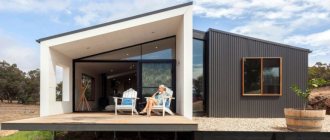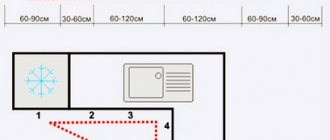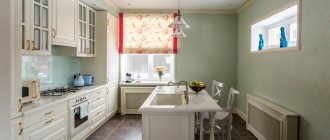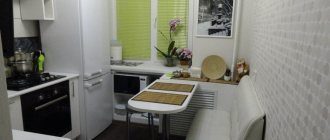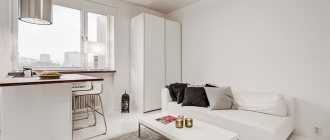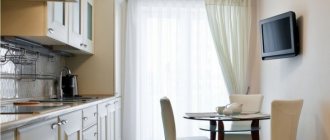“Khrushchevka” refers to houses that were built back in the 60s of the last century. As the architects of that time testify, they were built according to an accelerated program to solve the housing problem. Consequently, a relatively short service life of such houses was envisaged - from 25 to 50 years. They were equipped with all the engineering systems required at that time. In particular, there was natural exhaust ventilation; some houses were supplied with hot water using a gas water heater.
How to properly hang a speaker in the kitchen
When determining the future location of a gas water heater, they are guided by the current SP 62.13330 (formerly SNiP 42-01-2002), with the prescribed installation features. As a rule, the installation of the column is carried out after the preparation of project documentation. To properly connect a gas water heater, you will need to carry out the work strictly according to the existing wiring diagram.
Basic rules for the location of a gas water heater in the kitchen according to SNiP:
- Removal of combustion products - natural ventilation is required. The smoke removal system should not be forced. It is prohibited to use corrugated pipe as a pipe. Recommended steel: stainless or galvanized.
- It is prohibited to hang the speaker above a refrigerator, gas stove, or sink. The minimum distance between appliances is at least 0.4 m. An exception is a small kitchen with a gas water heater, less than 6 m². In such rooms it is allowed to connect a water heater above the sink.
- The kitchen volume is at least 21 m³, provided that the water heater power does not exceed 10 kW, and a 4-burner gas stove is installed.
- Kitchen aprons are made of fire-resistant materials. Ceramic tiles and plaster are suitable.
The height from the floor to the lower edge of the heater is 80-120 cm. The gap between the ceiling and the upper edge of the housing is at least 30 cm.
Correct positioning of the column is a necessary condition for its safe operation and prevention of accidents. Independent connection of a gas water heater is fraught with penalties and disconnection of the consumer from the gas supply.
Is it possible to move the speaker to another place in the kitchen?
Any changes: moving the column or replacing it require re-production of the gas supply project. Moreover, if the column was installed according to the old rules in force before 60, its installation will take place according to the SNiP in force today. Thus, in the old requirements it was allowed to install a gas water heater in the bathroom. Modern standards prohibit this. The column will need to be moved to the kitchen.
As for the placement of equipment, the apartment owner may encounter the following difficulties. Moving a gas water heater within the kitchen, without the need to change the design, is allowed within 1.5 m from the original location. If it is necessary to install a column on another wall or move it more than one and a half meters, this will be equivalent to laying a new gas main and will require approvals and the production of a new project.
Is it possible to combine a kitchen with a room if there is a gas water heater?
SNiP stipulates the requirements for premises where gas-consuming equipment can be installed. It is allowed to connect speakers and boilers in non-residential rooms and technical rooms. When remodeling a kitchen, several regulatory rules must be taken into account:
- It is necessary to have a door to the room with installed gas-consuming equipment, as well as a partition between the heater or boiler and the living rooms (December 30, 2009 No. 384-F3 “Technical Regulations on the Safety of Buildings and Structures”).
- Combining with the living room is possible only on the condition that the resulting room will not be used as a bedroom. A sliding screen is provided.
Combining a room and a kitchen is theoretically possible. Since 2011, most of the strict prohibitions have been eliminated. After the abolition of SNiP and the emergence of joint ventures (codes of rules). The document itself states that the requirements are advisory in nature. For small kitchens, increasing the area due to the square meters of the adjacent room may be the only way out.
Is it allowed to cover pipes from a gas water heater?
Strictly speaking no. Hiding pipes is allowed only if there is free access to them. In practice, this means that you can use a decorative box with inspection hatches or doors.
Hiding the pipes from the pump in blind niches: completely covering them with plasterboard or plastic would be a serious violation. At the next visit, the inspector will issue a fine and indicate the need to dismantle the decorative box, provided, of course, that it does not have windows for inspecting the pipeline.
Is it possible to install a hood in a kitchen with a column?
The use of natural supply and exhaust ventilation is allowed. You can install a hood in a kitchen with a gas instantaneous water heater only if it does not create forced air circulation.
The reason for this ban is simple. If a leak occurs, the artificial ventilation in the kitchen will direct the gas into the duct and spread to the apartments of neighbors who do not have an electric hood.
Is it possible to cover a column with a façade?
According to the rules described in SNiP, a gas water heater must be installed at eye level in the direct line of sight of a person. In fact, the consumer must see whether there is combustion (whether the column is working). At the same time, it is important to ensure an unimpeded flow of air necessary for gas combustion.
To mask a column, you need to take into account several current restrictions:
- It is impossible to cover a instantaneous gas water heater with the facade of the kitchen. The column can be built into a non-closing box. Some consumers simply remove the cabinet door before the inspector arrives and open it each time the heater is used.
- The box should not have a lower or upper part in order to ensure a full flow of air and not cause a fire due to heating of the flammable material of the cabinet from the heating surface of the chimney.
- The routing of the gas pipe to the stove and column should not be hidden by a blind box. Access is required via an inspection hatch or an opening door.
The gas water heater in the kitchen is not covered by the furniture façade. Violation is subject to penalties.
How to hide a gas water heater in the kitchen
It will not be possible to completely close the water heater. Therefore, it is recommended to purchase a kitchen set together with a gas water heater, so that the decor of the water heater matches the texture and appearance of the furniture.
It was described above that equipment built into the kitchen interior should not have a facade. The lower and upper parts are not installed in the box. A minimum gap of 15 cm is left between the walls of the column and the combustible surface.
Artificial ventilation
Additional draft in the exhaust system is created using fans. Their power and number depend on the air load on the channel and the volume of the room.
power is taken from the calculation: maximum load plus a reserve of 25-30%:
max * 1.25, where max is the maximum load;
the number of devices is selected in proportion to the volume of air required for pumping (increase the volume of the room three times):
(h + b + l) * 3, where h is the height of the ceiling, b is the width, l is the length;
the length of the chimney, its geometry and the number of bends are taken into account.
The fan is protected by an installation box. This box is made of non-flammable and stainless materials. Usually copper or aluminum alloys are used.
The design of artificial ventilation is similar to the installation of natural ventilation. After installing the supply pipe, the duct fan is installed. Next, the builders lay the wiring to power the engine, install sensors, a noise absorber and a filter. Just as when installing natural ventilation, grilles are attached to both ends of the pipe. The device for the exhaust pipe is installed in the same way, only taking into account that the air is drawn out and not pumped.
Artificial ventilation requires constant energy costs. Sometimes during construction they save money by installing a fan only for exhaust or only for air supply. However, more efficient circulation is achieved by using both.
The automatic ventilation system allows you to turn off the fans when the boiler is stopped and turn them on when it starts.
When to install
Installation of gas-fired water heating equipment in an apartment is usually carried out in the following cases:
- To heat water in the absence of hot water supply or when it is turned off for a long time for various reasons, a new gas water heater is purchased for this purpose.
- When changing the location of the speaker, move it to another room from a place not intended for its placement according to regulations.
- When purchasing new water heating equipment to replace the old one and installing it in the appropriate room without carrying out a large amount of installation work.
Rice. 2. Diagram of a column with piezo ignition
Why is ventilation needed?
Some owners of cottages and country houses doubt the need for ventilation or argue that an open window in the boiler room is sufficient to ensure air exchange.
However, it is impossible to keep the window open all the time. Often, for complete removal of exhaust air, a mechanized exhaust is necessary, so in addition to natural ventilation, it is necessary to install forced ventilation.
A corridor, hallway, kitchen are suitable for installing a gas boiler (according to the new rules, it is not allowed in the bathroom), but the best and safest place is considered to be a separate boiler room with an established ventilation system
The gas exhaust system performs very important functions:
- Supplies oxygen in the amount necessary to ensure the fuel combustion process. As is known, oxygen deficiency is fraught with such consequences as a decrease in heat transfer, incomplete combustion or an increase in the amount of required fuel, premature wear of equipment, and clogging of the chimney with fumes and soot.
- Removes combustion products. Some carbon monoxide can penetrate into the room even with proper installation and operation of the chimney, and its critical concentration in the air is a direct threat to the health of people living in the house.
- Removes gas if it accidentally gets into the air. The possibility of gas line leaks should also not be overlooked - propane leaks are rare, but they do occur. The result could be either poisoning of residents or a powerful explosion.
Only a well-thought-out ventilation system designed in accordance with SNiP requirements when installing a gas boiler can protect against negative consequences. Thanks to supply and exhaust ventilation, you will protect your family from explosion, fire and poisoning, reduce the load on the boiler, reduce fuel consumption and increase the heat transfer of heating equipment.
How to hang a speaker inside the kitchen
If you need to move the device less than one and a half meters, you can take this step without much thought - it will not require special permits or financial investments.
If the distance exceeds this figure, the action will be regarded as a reinstallation, therefore, it will be necessary to make changes to the existing project and lay gas lines.
You definitely can’t hang the column over a gas stove; it’s best to discuss other options with a specialist first.
When moving an appliance inside the kitchen, you need to carefully consider the rationality of this action and determine its pros and cons. Decide in advance what you need the free space for and whether the speaker will become a hindrance in the new location.
A few words about the refrigerator
The second Achilles heel of small kitchens in Khrushchev-era apartments is the placement of the refrigerator. It is difficult to hide a large unit; as a rule, there is no room left for this device, and it goes into the corridor, into the place of a former storage room, or even into the room. But the refrigerator can hardly be called a living room decoration.
Perhaps as part of your kitchen remodel, you might want to think about whether you really need a huge two-compartment household refrigerator? There is no shortage of food in stores, is it worth stocking up on frozen meat for six months in advance, or is it better to buy chilled meat as needed?
In addition to refrigerators with freezers, there are appliances on sale that only have a cooling chamber. They are much more compact - there is no need for a thick layer of thermal insulation and a large compressor. Such models are often designed for installation under a countertop.
There are also options for independent appliances: the freezer and refrigerator compartments are designed as independent separate appliances that can be more conveniently placed in the kitchen. Or even leave only the refrigerator in the kitchen area, because it is used more often. And put the freezer in another room.
If you approach the interior design of a small-sized kitchen thoughtfully, then a small area is not a death sentence. There is always an optimal solution for creating a comfortable living space.
Is it possible to make a suspended ceiling in a kitchen with a gas water heater?
To answer this question, you should find out what requirements are stipulated by regulatory documents. To cover the surface above a gas water heater, only non-combustible materials with an index of at least M1 are used - they cannot ignite on their own and cannot sustain combustion. This is the category assigned to film stretch ceilings.
During installation, several nuances are taken into account:
- the distance from the gas water heater to the suspended ceiling is at least 30 cm;
- heating temperature maintained without deformation of the ceiling material is 70°C;
- if the chimney goes into the ceiling, a gap of at least 30 cm around the circumference is left near the pipe.
Stretch ceilings in a kitchen with a gas heater are a good option that meets fire safety requirements. Existing regulations limit the use of flammable materials only.
The combination of a gas water heater and a suspended ceiling fully complies with SNiP and SP. Separately, it can be noted that the material does not contribute to the development of mold and the accumulation of condensation, which is considered an additional advantage that increases the operating comfort of the water heater.
Regulatory requirements
According to the table of definitions NPB 252-98, the exhaust pipe for a gas water heater is the connecting pipe for the smoke exhaust pipe of the device and the smoke duct. Accordingly, it transports gas combustion products and must meet the requirements for chimneys. Failure to comply with them can lead to gas pollution in the room and carbon monoxide poisoning.
All requirements for chimneys are set out in the following regulatory documents:
- NPB 252–98;
- Rules for the production of pipe and furnace works VDPO;
- SP 42-101-2003, Appendix G
- SP 60.13330.2012, which is an updated version of SNiP 41-01-2003 (replacing SNiP 2.04.05–91).
The main provisions that directly relate to smoke removal from household gas water heaters boil down to the following points:
- The cross-sectional area of the exhaust pipe is taken to be no less than the cross-section of the outlet pipe of the unit;
- It is necessary to ensure complete tightness of the chimney, its resistance to corrosion and high temperatures up to 200 °C;
- Laying connecting pipes through living rooms is prohibited;
- The vertical section of the exhaust pipe at the outlet of the column must be 500 mm high, in some cases it can be reduced to 250 mm;
- Connecting pipes should be up to 3 m long in new buildings and up to 6 m in existing ones;
- It is allowed to use no more than 3 turns with a bend radius no less than the diameter;
- The exhaust pipe is installed at a distance from the ceiling or wall made of non-combustible materials of at least 5 cm, if they are combustible or difficult to burn, then at least 25 cm. The distance can be reduced to 10 cm by taking protective measures in accordance with SP 42-101-2003;
- If the connecting pipe for a gas water heater passes through an unheated room, then thermal insulation must be used;
- The exhaust pipe must be laid with a slope of 0.01 or more towards the appliance.
Important! Removal of combustion products is possible only through smoke ducts or specially installed chimneys; the use of ventilation ducts is strictly prohibited. Smoke ducts are installed in walls made of non-combustible materials and insulated if necessary to avoid condensation.
If there are no suitable walls or the building in use does not have channels for removing combustion products, then install a top-type or root-type chimney
Smoke ducts are installed in walls made of non-combustible materials and are insulated, if necessary, to prevent condensation. If there are no suitable walls or the building in use does not have channels for removing combustion products, then install a top-type or root-type chimney.
Each fuel-burning device must have a separate smoke duct or pipe. In some cases, it is allowed to remove exhaust gases from the column and boiler into one chimney with an increase in the cross-section of the pipe. In this case, the combustion products must be introduced into the channel at different levels at a distance of at least 0.75 m or at the same level using a cut with a height of 0.75 m and a thickness of 0.12 m.
The chimney must be strictly vertical and have at the base a removable pipe or pocket 250 mm deep with a door for cleaning soot. If it is necessary to bypass existing obstacles, a deviation of up to 30° from the vertical is allowed, while the cross-sectional area is maintained, and the offset should not exceed 1 m.
The round or rectangular hole under the entrance to the smoke duct is intended for cleaning out soot and must always be accessible for maintenance. When doing general cleaning in the kitchen, do not forget to open the door and clean out soot, leaves and other debris.
The height of the chimney is a key factor in creating good draft. It is this that is decisive in the issue of high-quality removal of combustion products. The height of the chimney must be determined in accordance with the diagram given in SP 42-101-2003 (Appendix D).
If there are taller buildings or trees nearby, then it is necessary to additionally check the height of the wind pressure zone and, if necessary, increase the height of the chimney. In any case, the elevation above the adjacent part of the roof must be at least 50 cm, and with a combined (flat) roof - at least 200 cm.
in rooms with hermetically sealed windows, the geyser may periodically turn off due to insufficient air flow. The automation stops the operation of the water heater to prevent reverse draft, which may occur due to rarefaction of air in the room. To eliminate the problem, it is enough to keep the kitchen window in micro-ventilation mode while the column is running.
If a gas water heater is not provided
In a house where the installation of gas equipment, such as a stove, is permitted, the installation of a water heater may be prohibited. This restriction applies to houses with more than 11 floors. No regulatory authority will issue permission to install a water heater in such an apartment, as this is dangerous for the residents.
In addition to the number of floors, redevelopment may be a reason for refusal. Studio apartments are not suitable for installing gas equipment, since the devices must be installed in non-residential premises.
If the kitchen is combined with a living room, this makes the use of gas appliances illegal. These limitations must be taken into account before redevelopment. The same can be applied to apartments where there is no kitchen or is shared.
Image gallery Photos from Gas water heaters with a flow-through principle of operation in apartments are mainly used to prepare hot water; in old two-story buildings they can serve as a unit for maintaining the temperature of the coolant. Installation of a gas water heater is allowed in houses no higher than five floors that are not connected to a centralized hot water system. In high-rise buildings connected to a central hot water supply system, gas equipment is not installed. Small private houses with an area of no more than 150 m² are also equipped with gas flow heaters. The instantaneous water heater processes the water passing through it in the amount necessary for immediate use. The gas water heater is not intended to form a supply of hot water. and maintaining its temperature, which explains its small, easy-to-use dimensions. Gas instantaneous water heaters for apartments are available in wall-mounted versions. They should be located so that free access is guaranteed for servicing the water heater and its connection points. Installation of more than two gas water heaters in one room is not allowed. The use of both flow and storage equipment is allowed in quantities of 1 piece each. An exception is multi-level apartments. Gas heating equipment is allowed to be installed only in private apartments and houses; placement in dormitories, gyms, hotels, etc. is prohibited. where different people can be used Flow-through gas water heater Productive small-sized device Operation of a water heater in private homes Advantages of a gas water heater Compact dimensions of flow-through equipment Features of heater placement Two gas water heaters in one room Installation of the heater only in residential buildings and apartments
If the house does not fall under these restrictions, then it is necessary to collect a package of documents to register the device.
The procedure is as follows:
- Write an application to the gas distribution company.
- Get a plan from the BTI or Rosreestr.
- Provide an extract from Rosreestr confirming ownership.
- Contact a specialized organization to draw up a project.
- Find certified specialists from an organization that has access to gas work.
After this, specialists will make an insert into the gas pipe, connect the device and put the water heater into operation.
It is highly not recommended to install a geyser yourself, bypassing the legal order. These actions not only lead to fines, but also put people's lives at risk.
Step-by-step instructions for constructing a smoke exhaust system
When commissioning the equipment, room ventilation must be taken into account. In the absence of air exchange, forced turbo exhaust must be installed. Without it, putting a gas boiler into operation is impossible. We will look at how to install a hood for a gas boiler in a private house using the example of a coaxial chimney. The length of the pipe from the boiler room to the street for this type of hood cannot be more than two meters.
- When starting work, make sure that the installation of the gas boiler complies with the rules and regulations approved by inspection organizations in order to avoid reworking the entire power unit.
- Select the appropriate material for the hood, taking into account the parameters of the gas outlet: gas boiler inlet = pipe diameter.
- Calculating the power of the fans and their number, taking into account how long the hood is, the number of bends in its structure, and the position in space relative to the horizon, at what height the exhaust pipe is located in the room.
- Do not forget about the features of budget equipment indicated in the technical passport.
- All materials used in the work must be fireproof and not susceptible to corrosion.
- After making sure that all parts are intact, we proceed to assembly. We connect the chimney elbow to the gas boiler pipe using a tee.
- To extend the coaxial pipe and connect all its parts, special crimp clamps and fire-resistant sealants are used.
- Turbo exhaust is used if there are more than two elbows in the pipeline geometry. This helps maintain the efficiency of the gas boiler. The fan and all sensors are installed after installing the supply pipe.
- Installing a coaxial pipe outside a building is no different from installing a conventional sandwich chimney.
We recommend that you read: Ventilation grille with non-return valve
Outside the building
Having laid the line for the exhaust device in the house, the design of the hood for the gas boiler goes outside.
- As soon as the pipe has been brought outside through a hole in the wall, it must be closed with special metal plates. The remaining space between the pipe and the wall is filled with mineral wool.
- Now we install the tee. The lower hole is closed with a plug with an inspection for cleaning the pipe.
- We increase the chimney to the required length by connecting the parts using a special sealant and clamps with gaskets. As the pipe grows, we attach it to special brackets.
- We install a protective cone at the top of the chimney and additionally attach it to guy wires in those places.
- If the chimney structure was not coated with special paint at the factory, this can be done at home. This is done to protect the metal from environmental influences.
You can see how to connect a gas water heater to the chimney system and how to assemble it in the video.
Inside the house
Inside the house, the installation of a coaxial chimney was described in detail, with comments, above. The only step you have left to do is to connect two pipes, street and indoor, using the extension method. For additional insulation, it is recommended to use special metal tape.
I would like to note an important advantage of a coaxial chimney - the absence of additional holes in the roof or wall of your home
Decorative elements
The easiest way to hide a geyser with your own hands is to stick decor on it and cover it with some safe colored film.
You're lucky, if the speaker is located near a window, it can be hidden under a kitchen curtain made of curtain-like material.
Stylish and modern geyser with small decorative elements: sea world
- To do this, you need to install a decorative wooden cornice above the device.
- Sew a small curtain from fabric to which rings are attached.
- Any wire or strong thread can be used as a string.
Note! This option will not raise any unnecessary questions from gas services and will fit interestingly into the interior.
Hide or decorate?
Before deciding what to do with a geyser, you need to decide what financial capabilities you are based on and to what extent you visually dislike this device. If you are ready to allocate a small amount for a more harmonious appearance of the speaker, and it does not cause much outrage, you can simply decorate it. If the rejection is strong and you want to hide it completely, you will have to spend a more serious amount.
Pipes and chimney
From below, many pipes are connected to the column: gas, cold water supply, hot water outlet. And a chimney comes out of it from above. All this also requires registration.
To do this, you can use special boxes, which are often included with the unit.
If not, you can purchase them at hardware stores or make them yourself from plastic, plywood or drywall.
Finishing in the color of the kitchen apron will make the pipe boxes almost invisible. But do not forget that they must be easily removable or have an inspection door.
Can't be moved, hidden
One of the frequently proposed ways to solve the problem of a small kitchen and place all the necessary furniture and equipment in it is to make drastic changes - combining the kitchen and living room. But if you are a law-abiding citizen, then you cannot do a redevelopment that combines the kitchen and living room. More precisely, it is possible, but only if the stove in the kitchen is electric and the water heater is too. Gas equipment - a stove or gas burner is required to be installed in a room separated from living rooms by a wall with a door.
Just like in a fairy tale, the placement of the comma in this phrase is of great importance. If you decide that the amount of work, approvals and financial costs is not worth modern kitchen interior design, then we will try to solve the problem using decorative methods.
- Geyser as part of a kitchen set . This is the simplest and most obvious way: enclose the gas water heater in a furniture cabinet, then from the outside it will not be noticeable where the device is located - it will be hidden by the cabinet door. When ordering furniture, you should only take into account the requirements for the installation of gas appliances.
- Geyser in a decorative casing. From the advice given above, another solution follows: modern models of gas instantaneous water heaters can have not only a functional, but a beautiful body that you do not want to hide. There are very decorative solutions: with a glass panel decorated with painting or photo printing.
- Geyser and refrigerator . It’s worth talking about a refrigerator in a small kitchen, but now let’s mention the option of a tandem refrigerator and geyser. If the location of the column allows, you can place a small refrigerator under the column. This option also requires the use of modern models of gas water heaters. Their design is such that the burner is located in the upper part and the bottom of the device does not heat up. In addition, they have automatic ignition: the burner flame lights up when the water is turned on, so there is no need to provide easy access to turn on the burner. When placing appliances in this way, you should take into account where the stove is located so as not to damage the refrigerator.
- If you can’t hide it, you need to show it beautifully . In an industrial or loft style interior, a gas water heater, pipes and chimney can become part of the design. Another option is suitable for a country style interior. Hang wooden shelves in a retro style on the sides of the gas water heater, place beautiful dishes or kitchen utensils on them, and draw a shelf with objects on the body of the water heater.
Replacing an old column with a new one
The option that is considered the safest and most correct.
- First, you are removing from the premises an appliance that could have lasted more than 30 years. Still, this is too much for such unsafe devices.
- Secondly, you install a new and stylish speaker in the kitchen, which can easily fit into your style in appearance. Look at the photo below.
Elegant design allows you to use the speaker without any decorative elements
Can such a column be called superfluous in the interior?
For your information! This service can also be carried out with the help of specialists, but the cost will significantly hit your pocket.
To replace the column yourself you will need:
- Pipe wrenches.
- Thread cutting kit.
- Angle grinder.
- New column.
- Tap and gas supply.
The tool is easy to use; if necessary, you can rent it at a hardware store.
But do not forget that the replacement must be carried out legally, that is, documented. To do this, after finishing work, call the gas special services workers so that they take over the work. You will have to pay extra for this, but not as much as you would have to pay to replace a gas water heater by a specialist.
Only after the service employee accepts your column and signs the document, you can safely use it.
Note! Without official confirmation, all responsibility in the event of an accident will fall on you. It is especially important to take this into account when the apartment undergoes a major renovation, which entails moving the speaker from one part of the room to another.
Varieties
There are several types of household gas appliances.
- A gas stove is a device that is designed for cooking food directly on the stove. Appliances include from one to four burners. The stoves are available with or without an oven.
- Geyser - designed for heating water in a residential area. The dispensers are automatic (they light up on their own and maintain the set water temperature), semi-automatic (require adjustment depending on the water pressure, etc.), manual (each time you need to manually start the dispenser and monitor its operation).
- Gas boiler - designed to work in a room heating system if the boiler is single-circuit, and for heating and heating running water - if it is double-circuit.
- Gas burners for heating stoves - the name itself speaks about its purpose, that is, for heating a room using brick stoves.
- Gas metering devices are designed to record the amount of fuel pumped through them. For the consumer, this means the amount of substance used.
Interior and column
The easiest way to fit a speaker into the overall idea of the kitchen is to decorate it by painting it with non-flammable paint or covering it with vinyl film. You can also use stencils to apply an interesting design to the surface of gas equipment. An interesting option is to decorate the speaker with magnets brought from travel or stickers.
Family photos printed on magnetic vinyl will look good on the speaker. Speakers painted with slate paint look especially impressive. On such a surface you can leave messages, write menus and simply draw.
Main location options
Due to the small number of Khrushchev kitchens, the number of options for the location of the column is strictly limited and depends primarily on the type of layout you choose.
With a linear layout
The kitchen set is located along one wall. The column is mounted above the sink (not recommended, but acceptable for small rooms of 4-6 square meters) or above the work surface. With this ergonomics, the proximity of the heater to the stove and refrigerator is excluded: the first is placed closer to the window, and the second is often placed on the opposite wall, right next to the dining area.
With a corner layout
The set is already located along two adjacent walls, forming an easily readable letter “G”. This ergonomics is considered more convenient, since the rule of the working triangle (cooking, storage and washing areas) has not been canceled. The column is placed in the corner and in the vast majority of cases is hidden behind cabinets.
How to place a refrigerator and gas heater in the kitchen
When installed correctly, a technological gap of 40-80 cm is maintained between the column and the refrigerator. In old “Khrushchev” buildings, it is not possible to maintain such a distance. Often the water heater is placed directly above the refrigerator, which is not entirely correct from the point of view of the current codes of practice (SP).
Modern gas water heaters with closed combustion chambers, in the combination described above, work without problems. Installing a water heater has a greater impact on the functionality of the refrigerator (the manufacturer's instructions indicate that placing equipment near any heating equipment is prohibited). Inspectors turn a blind eye to this minor violation, allowing the operation of gas water heating equipment.
Before planning to replace the dispenser or move it, you should seek advice from the Gas Service. Incorrect connection, violations during installation of the water heater or cladding of walls and ceilings lead to equipment shutdown and penalties.
Summary
Having chosen a hood by carefully selecting it to match the color and design of the kitchen unit, you are faced with a choice: turn to professionals for help in installation, paying a substantial fee for installing a kitchen hood; or hang it yourself, after reading our article.
The most important thing when installing a kitchen hood is: objectively assess your strengths and the possibility of receiving help from household members; evaluate the instrumentation before starting work; understand the instructions included with the hood and believe in yourself.
Is it possible to swap the kitchen and bathroom? Or a kitchen and living room? And even with moving the gas stove?
There are a lot of nuances, restrictions and requirements. First you need to obtain technical specifications. In Moscow, they are issued at the one-stop service of JSC MOSGAZ (Mruzovsky per., 11, tel. 8 (495) 660-60-80). Then - order a reconstruction project and have it approved by the Moscow Housing Inspectorate. Then, enter into an agreement with a construction and installation organization (which has a permit for such types of work) so that it will install the gas pipeline according to the project. You do not have the right to do all this on your own, even if you have golden hands.
And plus - after all these manipulations - you need to provide Mosgaz with technical documentation for inserting the gas pipeline into the existing network.
We also remind you: it is prohibited to place a gasified kitchen directly above and below residential premises (this is stated in the order of the State Committee for Architecture of December 26, 1989 N 250). Gas stoves in residential buildings are allowed to be installed only in kitchens where the ceiling height is at least 2.2 m, there is a window with a window (transom), an exhaust ventilation duct and natural lighting. Before breaking down walls, think about how legal the redevelopment you are planning is.
How to calculate ventilation in a private house
When calculating ventilation, an indicator such as the air exchange rate is used. It was already mentioned at the beginning of the article. This parameter is recorded by SNiP under number 2.08.01-89* under the name “Residential buildings”. So in Appendix No. 4 there is a table in which the air exchange rate is shown depending on the purpose of the room. We will not rewrite the entire table; we will indicate the main premises:
| Room | Air exchange rate |
| Residential | 3 m³/hour for each square meter of area with a ceiling height of 3 m |
| Kitchen with electric stove | 60 m³/hour |
Kitchen with gas stove:
|
|
| Bathroom | 25 |
| Toilet | 25 |
| Combined bathroom | 50 |
Now, as for the calculation. The formula used for this is:
N = V x L, where
- N – ventilation performance,
- V is the volume of the room,
- L is the air exchange rate.
Pay attention to the multiplicity in residential areas. In principle, it turns out that it is equal to “1”. That is, in one hour the volume of air in them should change completely
It turns out that the ventilation performance should be equal to the volume of the room
That is, in one hour the volume of air in them should change completely. This means that the ventilation performance should be equal to the volume of the room.
But this is just a calculation that is based on standards. The ventilation system itself consists of air ducts, which must provide the necessary permeability of air masses. Therefore, there are rules here too. For example, a round pipe with a diameter of 150 mm, and this cross-section equal to 0.016 m³, provides a throughput of 30 m³/hour. The same parameter supports a rectangular duct of 100×100 mm. At the same time, such a volume is supported by a riser height of 3 m. That is, if this value is less, productivity will decrease accordingly.
Calculation example diagram
Calculation example. Input data:
- total area of residential premises – 60 m²;
- The kitchen has a 4-burner gas stove;
- toilet and bathroom are separate;
- ceiling height – 3 m;
- inflow from living quarters, exhaust from the kitchen, bathroom and toilet.
First of all, the volume of supply air is calculated. It is equal to the volume of residential premises: 60 × 3 = 180 m³/h. Now we need to calculate the volume of exhaust air. Here you will have to refer to the table:
- in the kitchen this figure is 90 m³/h,
- 25 in the toilet and bathroom.
In general it turns out: 90 + 25 + 25 = 140 m³/h. Now the two obtained values must be compared. It is clear that 180 is greater than 140. This means that the performance of the ventilation system in this particular case will be 180 m³/hour.
This calculation is valid for both natural and mechanical ventilation.
Decorating
The easiest and cheapest way is to apply stickers. Choose heat-resistant materials and colors that will harmonize well with the overall interior.
If the device is located near a window, close it with a curtain. To do this, install the cornice on top, at some distance from the body. Hang a curtain made of thick, opaque material.
Do you want to create an art object in the kitchen? Then arm yourself with paints and a brush. You can paint in a themed style or paint the cladding in the colors of the walls or kitchen units. Here is the decision the owner of this model made:
The design can also be applied using a stencil and heat-resistant enamel for metal work. Quite a simple solution, especially for people without artistic skills.
What determines the effective operation of the ventilation system?
Considering that the ventilation system in Khrushchev-era buildings does not provide for the use of a mechanical method for the removal and entry of air masses, many factors have a significant influence on the efficiency of its operation:
- number of storeys;
- window and door material;
- ventilation duct material;
- apartment layout;
- maintenance of ventilation shafts.
How often unpleasant odors from other rooms will penetrate into it depends on what floor your apartment is located on. According to the laws of physics, residents of the upper floors suffer the most from this, since warm air, being lighter, supported by heavy cold air from below, will in any case tend to leave the living quarters upward. Therefore, residents of the 4th and 5th floors more often hear that their neighbors from the lower apartments are cooking in the kitchen.
When the Khrushchev projects were developed, it was assumed that people would provide constant ventilation by opening the windows. However, in the modern world, old wooden frames are becoming a thing of the past everywhere, giving way to plastic double-glazed windows that have a high degree of tightness. Hence the reduced air exchange, when fresh cold air does not enter the apartment, and thus draft and normal air exchange are not created.
For good ventilation in the apartment, plastic windows must be regularly opened for ventilation.
The same can be said about entrance doors. New modern materials and technologies have completely eliminated the usual small drafts that formed with old doors.
A lot depends on the layout of the apartment. Initially, in Khrushchev-era buildings, one room was usually a passage room.
We use PVC panels
The properties of plastic panels allow them to be easily used as finishing materials for premises:
- Environmentally friendly - there are no toxic fumes.
- Durable and reliable - can be used without deformation for many years.
- The widest selection of colors and textures.
The most important thing when choosing PVC panels is to match them to the interior of the kitchen. In most cases, this is quite problematic, since it is rare that kitchen walls are covered with panels.
Disadvantages include the impossibility of permanent access to the column, which may entail a fine from inspection services.
Placed between wall cabinets
There are situations when it is not possible to build a speaker into a set, but it can be hidden between wall cabinets. This arrangement option is practical and does not require costs.
It must be remembered that in this case there are certain requirements:
- the distance between the side walls of the column and wall cabinets must be at least 3 cm;
- the walls of adjacent cabinets must be insulated with non-combustible material.
Important! The color of the speaker should match the set or, conversely, be a bright accent in the interior.
